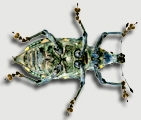Evans AM, McKenna DD, Bellamy CL, Farrell BD.
Large-scale molecular phylogeny of metallic wood-boring beetles (Coleoptera: Buprestoidea) provides new insights into relationships and reveals multiple evolutionary origins of the larval leaf-mining habit. Systematic Entomology. 2015;40 (2) :385-400.
DOI (full text)AbstractThe family Buprestidae (jewel beetles or metallic wood-boring beetles), contains nearly 15000 species in 522 genera. Together with the small family Schizopodidae (seven species, three genera), they form the superfamily Buprestoidea. Adult Buprestoidea feed on flowers or foliage, whereas larvae are mostly internal feeders, boring in roots or stems, or mining the leaves of woody or herbaceous plants. The subfamilial and tribal classification of Buprestoidea remains unsettled, with substantially different schemes proposed by different workers based on morphology. Here we report the first large-scale molecular phylogenetic study of the superfamily Buprestoidea based on data from four genes for 141 ingroup species. We used these data to reconstruct higher-level relationships and to assess the current classification and the origins of the larval leaf-mining habit within Buprestoidea. In our analyses, the monophyly of Buprestoidea was strongly supported, as was the monophyly of Schizopodidae and its placement sister to Buprestidae. Our results are largely consistent with the generally accepted major lineages of buprestoids, including clearly-defined agrilines, buprestines-chrysochroines and early-branching julodines-polycestines. In addition to Schizopodidae, three of the six subfamilies were monophyletic in our study: Agrilinae, Julodinae and the monogeneric Galbellinae (Galbella). Polycestinae was monophyletic with the exception of the enigmatic Haplostethini. Chrysochroinae and Buprestinae were not monophyletic, but were recovered together in a large mixed clade along with Galbella. The interrelationships of Chrysochroinae and Buprestinae were not well resolved; however they were clearly polyphyletic, with chrysochroine genera falling into several different well-supported clades otherwise comprising buprestine genera. All Agrilinae were contained in a single strongly supported clade. Coraebini were dispersed throughout Agrilinae, with strong nodal support for several clades representing subtribes. Neither Agrilini nor Tracheini were monophyletic. The leaf-mining genus Paratrachys (Paratracheini) was recovered within the Acmaeoderioid clade, consistent with the current classification, and confirming the independent origins of leaf-mining within Polycestinae and Agrilinae. Additionally, our results strongly suggest that the leaf-mining agriline tribe Tracheini is polyphyletic, as are several of its constituent subtribes. External root feeding was likely the ancestral larval feeding habit in Buprestoidea. The apparent evolutionary transitions to internal feeding allowed access to a variety of additional plant tissues, including leaves. Interestingly, the several genera of leaf-mining agrilines do not form a monophyletic group. Many of these genera are diverse and highly specialized, possibly indicating adaptive radiations.
McKenna DD, Farrell BD, Caterino MS, Farnum CW, Hawks DC, Maddison DR, Seago AE, Short AEZ, Newton AF, Thayer MK.
Phylogeny and evolution of Staphyliniformia and Scarabaeiformia: forest litter as a stepping stone for diversification of nonphytophagous beetles. Systematic Entomology. 2015;40 (1) :35-60.
DOI (full text)AbstractThe beetle series Staphyliniformia exhibits extraordinary taxonomic, ecological and morphological diversity. To gain further insight into staphyliniform relationships and evolution, we reconstructed the phylogeny of Staphyliniformia using DNA sequences from nuclear 28S rDNA and the nuclear protein-coding gene CAD for 282 species representing all living families and most subfamilies, a representative sample of Scarabaeiformia serving as a near outgroup, and three additional beetles as more distant outgroups. Under both Bayesian inference (BI) and maximum likelihood inference (MLI), the major taxa within Staphyliniformia are each monophyletic: (i) Staphylinoidea, (ii) Hydrophiloidea s.l., and the contained superfamilies (iii) Hydrophiloidea s.s. and (iv) Histeroidea, although Staphylinoidea and Hydrophiloidea s.l. are not strongly supported by MLI bootstrap. Scarabaeiformia is monophyletic under both methods of phylogenetic inference. However, the relative relationships of Staphylinoidea, Hydrophiloidea s.l. and Scarabaeiformia differ between BI and MLI: under BI, Staphyliniformia and Scarabaeiformia were sister groups; under MLI, Hydrophiloidea s.l. and Scarabaeiformia were sister groups and these together were sister to Staphylinoidea. The internal relationships in Scarabaeiformia were similar under both methods of phylogenetic inference, with Cetoniinae, Dynastinae+Rutelinae, Hybosoridae, Passalidae, Scarabaeidae and Scarabaeinae recovered as monophyla. Histeridae comprised two major clades: (1) Abraeinae, Trypanaeine and Trypeticinae; and (2) Chlamydopsinae, Dendrophilinae, Haeteriinae, Histerinae, Onthophilinae, Saprininae and Tribalinae. The relationships among early-divergent Hydrophiloidea differed between BI and MLI, and overall were unresolved or received only moderate to low nodal support. The staphylinoid families Agyrtidae, Hydraenidae and Ptiliidae were recovered as monophyletic; the latter two were sister taxa, and Staphylinidae+Silphidae was also monophyletic. Silphidae was placed within Staphylinidae in close relation to a subset of Tachyporinae. Pselaphinae and Scydmaeninae were both recovered within Staphylinidae, in accordance with recent analyses of morphological characters, although not always with recently proposed sister taxa. None of the four major groups of Staphylinidae proposed by Lawrence and Newton (1982) was recovered as monophyletic. Certain highly specialized staphyliniform habits and morphologies, such as abdominal defensive glands and reduced elytra, have arisen in parallel in separate lineages. Further, our analyses support two major transitions to an aquatic lifestyle within Staphyliniformia: once within Staphylinoidea (Hydraenidae), and once within Hydrophiloidea s.l. (Hydrophiloidea s.s.). On a smaller scale, the most common transition is from litter to subcortical or to periaquatic microhabitats and the next most common is from litter to carrion and to fungi. Overall, transitions to periaquatic microhabitats were the most numerous. The broad picture in Staphyliniformia seems to be a high level of evolutionary plasticity, with multiple possible pathways to and from many microhabitat associations, and litter as a major source microhabitat for diversification. In Scarabaeiformia, the most common transitions were from litter to foliage, with flowers to litter, litter to flowers, and litter to dung being next, and then litter to roots, logs or carrion. Litter is again the largest overall source microhabitat. The most common transitions were to foliage and flowers.It thus seems that the litter environment presents ecological and evolutionary opportunities/challenges that facilitate entry of Staphyliniformia and Scarabaeiformia into new' and different ecological adaptive zones.
